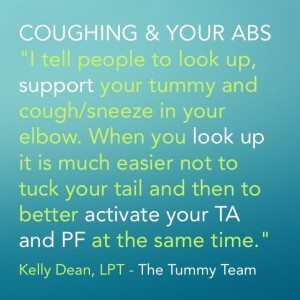Blog
Protecting Your Abs When You’re Coughing & Sneezing
A few weeks ago I jumped on a trampoline for the first time in a long while, and right after I came down with a colossal 3-day head cold. HooWee! Let me tell you! Even though I’m certain that I’ve laid a good foundation in my core and pelvic floor (PF) with great exercises like walking, proper kegels, mula bandha, plus lots of hamstring and calf stretches (yes those things all help our lady bits to be stronger and more supple) and even though I’m proud to report that I didn’t experience any leaking after bouncing around like a crazy woman, I still didn’t take my core for granted in the face of multiple stressors.
A stressor is anything that puts extra force or pressure on something else. Even strong muscles get tired when they face back-to-back stressors, and when muscles get tired and don’t have time to rest and rebuild, more fatigue happens, and too much fatigue can lead to “failure.” Coughing up a lung for 3 days straight is a stressor. Nose blowing, sneezing, sit jumps, flips, running around in circles… those are ALL stressors to your core. By the way, have you seen my recipe for making homemade elderberry syrup? I swear it prevents and shortens colds and coughs in our house big time! Okay, now back to your core…
By the way, have you seen my recipe for making homemade elderberry syrup? I swear it prevents and shortens colds and coughs in our house big time! Okay, now back to your core…
Stressors can make you stronger, or they can weaken you further. It depends on how you face them, prepare for them, and recover from them. Hold on, some of you may be wondering why I would even be worried. After all, I’m so buff and perfect in all my ways, right? Ha! Not! I’m on this journey with you, my friend! And head colds and trampolining are not in my usual repertoire of activities. I hadn’t jumped on a trampoline in years! Nor had I experienced an awful sick bug in over a year! Any relatively new stressor – particularly such a high impact and massively repetitive stimulus (like sneezing) that differs from my typical training methods – would be read as a “new move” by my body.
We must always be aware of new stimuli after there has been an injury to any area in our body, even if that injury has healed. I’ve had diastasis recti and an episiotomy and a 3rd degree tear. I’ve done rehab with The Tummy Team to fix all that, and I’m not eager to undo my hard work and investment by throwing caution to the wind. So therefore, knowing I could be facing a potential “fatigue to failure” situation, I didn’t just sit back and wait for my deepest core muscles to do their job and assume some type of muscle failure wouldn’t happen.
I nourished my nether region. I babied my belly. I protected my pelvic floor. I aligned my a– ALRIGHT enough with the alliterations! Let me spell it out for you… Preventing an epic fail and further damage such as prolapse or a widened diastasis recti is all about planning ahead and preparing your muscles to work right in the first place.
Here’s what you can do before, during and after a round of coughing, sneezing or jumping to prevent problems:
How to prevent problems before:
What can you do to protect your abs and private parts when you feel a cough or sneeze coming, or when you’re about to go jumping or running?
- Get into good alignment: When we’re sick or just not ready for a certain physical activity, we tend to begin with poor form. However, sneezing and jumping are both very strenuous activities. The more aligned you are, the better your muscles will be positioned to function with optimal strength. Whether you’re standing or sitting, getting ready to blow your nose or leap into the air, line your body up: ears over shoulders over ribs over hips over knees over ankles. Then have at it!

- Start with an exhale! Sneezing and blowing your nose are both just one big exhale, but exhaling (breathing out) naturally activates your pelvic floor and your transverse abdominus (TA). Think of it as “pre-flexing.” I teach you how to do this HERE in this free video which is one of our Foundational Five Fitness routines where we start every member of Fit2B.
- How I do these things: My awareness is likely higher than most with all the education in my brain and passion in my heart that I have for fitness and wellness. Sometimes I wish I could switch it off for a while, and I confess I do slump sometimes. Hey, I’m human! But I actually had fun trying different positions and breathing patterns to see what worked when I was bouncing around and later when I was hacking up a lung. I even took notes which is how this blog article was born. For sure, I felt much less pressure to my abdomen and pelvic floor when I was holding myself erect and exhaling to engage prior to the stress happening.
How to prevent problems during:
When you’re in the middle of jumping, coughing, sneezing, or laughing, what can you do to protect your core?
- Connect your breathing with the work: Exhale to engage with each exertion. Put simply, breathe out with the work. Be pre-flexed on the impact. And don’t forget, each cough and sneeze is major impact on your body. Achoo! Boom!
- Look Up! I love what Kelly Dean, licensed physical therapist and founder of The Tummy Team told me that she tells her clients: “I tell people to look up, support your tummy and cough/sneeze in your elbow. When you look up it is much easier not to tuck your tail and then to better activate your TA and PF at the same time.”
- Support Your Abs: When you cover your mouth with one hand or elbow, cover your tummy with the other one. If you are pregnant or still in the healing stage of fixing a dysfunctional diastasis recti or hernia, it’s wise to splint your abs during a cold or bouts of strenuous activity. If you don’t have a splint like the ones I recommend here, you should at least put a hand in front of your belly.
- Support your Pelvic Floor: This tip comes from Mama Lion Strong who wrote to me and said, “I’m glad you tackled this. This is actually a pretty big issue! I have myself and had clients that catch colds while in hospital delivering and their pelvic floors cannot cope. I give them many of the same cues you gave here, and also told moms to support their pelvic floors when coughing and sneezing with whatever – a rolled up towel or even their hands.” Excellent advice!
- Stop before your muscles get so tired they fail you! This is when leaking happens, and leaking isn’t the sign of a good workout, nor is it something to ignore! It means you’ve gone too far. So if you leak after 15 minutes on the trampoline, next time go for 10 minutes. If you have leaking issues for the following week after doing 15 box jumps, next time try doing just 6-8 jumps and work up or down from there based on how your body responds. If you have a bad cough, do something about it; don’t just hack away without trying to treat it. Do your best to shorten the attacks!
- How I did this: When I was on that trampoline, I could feel my PF meeting the extra pressure of each jump on that trampoline. I would inhale when I was in the air and start exhaling (breathing out) just before I’d land and jump back up again. I’d stay engaged through several jumps and then take another good breath and engage again. When I felt a little tired or couldn’t coordinate my breathing, I’d bounce lower or get off for a minute. The moment I felt a slight urge to “let go” I got off for good before I really did let go. Done for the day. Tired but no leaks. Stopping while I was ahead.
How to prevent problems afterward:
What are some ways you can immediately work to recover your core and pelvic floor right after jumping or between rounds of coughing and sneezing?
- Be still and connect: Close your eyes for a moment.You did your best to stay connected during the work, now connect again afterward by taking some belly breaths, drawing your navel in gently as you breathe out to stabilize your body from the center outward. Align your body. Stack your bones. Feel for what areas of your body are happy with what you just did, and feel for the places that are wobbly and “off.” Offer those areas a gentle flex and release. Stretch a little bit. Get a drink of water. Relax.
- How I did this: As soon as I got off the trampoline, I stood still, aligned myself, and spent a couple minutes doing some breathing and gentle TA holds. As I did that, I could feel how tired my PF was and how it was responding differently than normal. It wasn’t as quick on the draw, per se, but it was responding. It wasn’t too tired. In terms of coughing, after I could breathe straight again, I would lengthen my body out, reach and turn, drink some water, take a belly breath, engage my pelvic floor gently, do some neck rolls… and then go back to watching TV with bleary eyes 😉
How to prevent problems every day:
What are some things you should consider on a daily basis if you’re dealing with pelvic floor or core issues such as incontinence and diastasis recti.
- Physical Therapy: Those things I just listed are all symptoms of weakness, injury and/or dysfunction in your core and all of that is typically treatable without surgery. They are very correctable with the supervision of a qualified professional who can analyze your movement patterns, your personal needs, and give you a set of personalized instructions. See our directory of vetted experts here.
- Fitness Mode: If your fitness mode isn’t improving your symptoms or it’s making them worse, please change what you’re doing. Here at Fit2B we specialize in providing family-friendly workout routines for diastasis recti, pelvic floor issues, hernia, sore knees, back pain, shoulders, neck – everything really – that strengthen and tone your core and entire body in ways that lessen and improve your issues. Not make them worse!!!
- Flexibility: This goes with fitness, as stretching should be a part of everyone’s daily exercises, but stretching doesn’t always get the focus required to achieve measurable improvements. Now that you know that lengthening your hamstrings and calves helps your pelvic floor function better, aren’t your more motivated to unfold yourself?
- Alignment: The way you sit matters. The way you stand matters. The way you drive matters. The way you cook dinner matters. The way you sleep matters. “Form follows function” is one of the key things I teach my clients. If you live in a saggy position, you will have a saggy core and a saggy pelvic floor.
The Bottom Line
Plan and Prepare (and read Part 2 of this series where I give you 7 cues) Just like you’d set your body up for a race by drinking more water and fueling your body with the right types of energy, set your pelvic floor and core up for success, not failure when you feel a cold coming on or when your kids ask you to jump in mud puddles. There are things you can do before, during, and right after a sneeze or cough to minimize stress to your abs and most intimate muscles. There are things you can do before, during and after running, jumping, and laughing hard to prevent problems as well. When you know you will be jumping, coughing, sneezing, laughing, you also need to know that those things are the real workout for your core pelvic floor. Be ready for it! Part 2: Seven Cues for Protecting Your Core When You Have A Cold 


Pingback: In Defense of Those Who Exercise at Home | Fit2B Studio
Pingback: 30 Fitness Blogs in 30 Days from Fit2B
Fantastic article with great advice that might seem like common sense, but definitely not common advice. In other words, a gem. Thank you. Needed these tips and looking forward to learning more about your work.